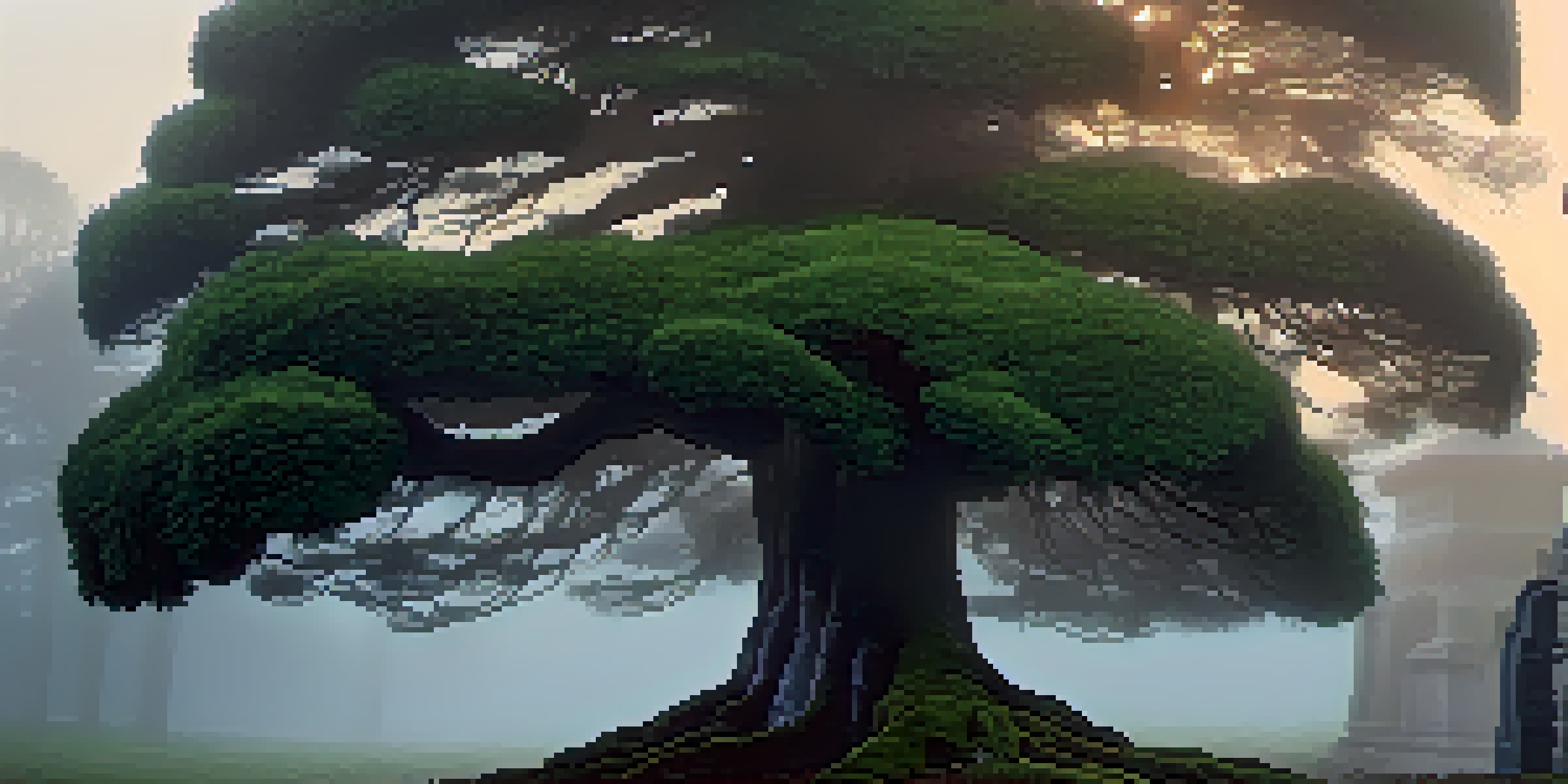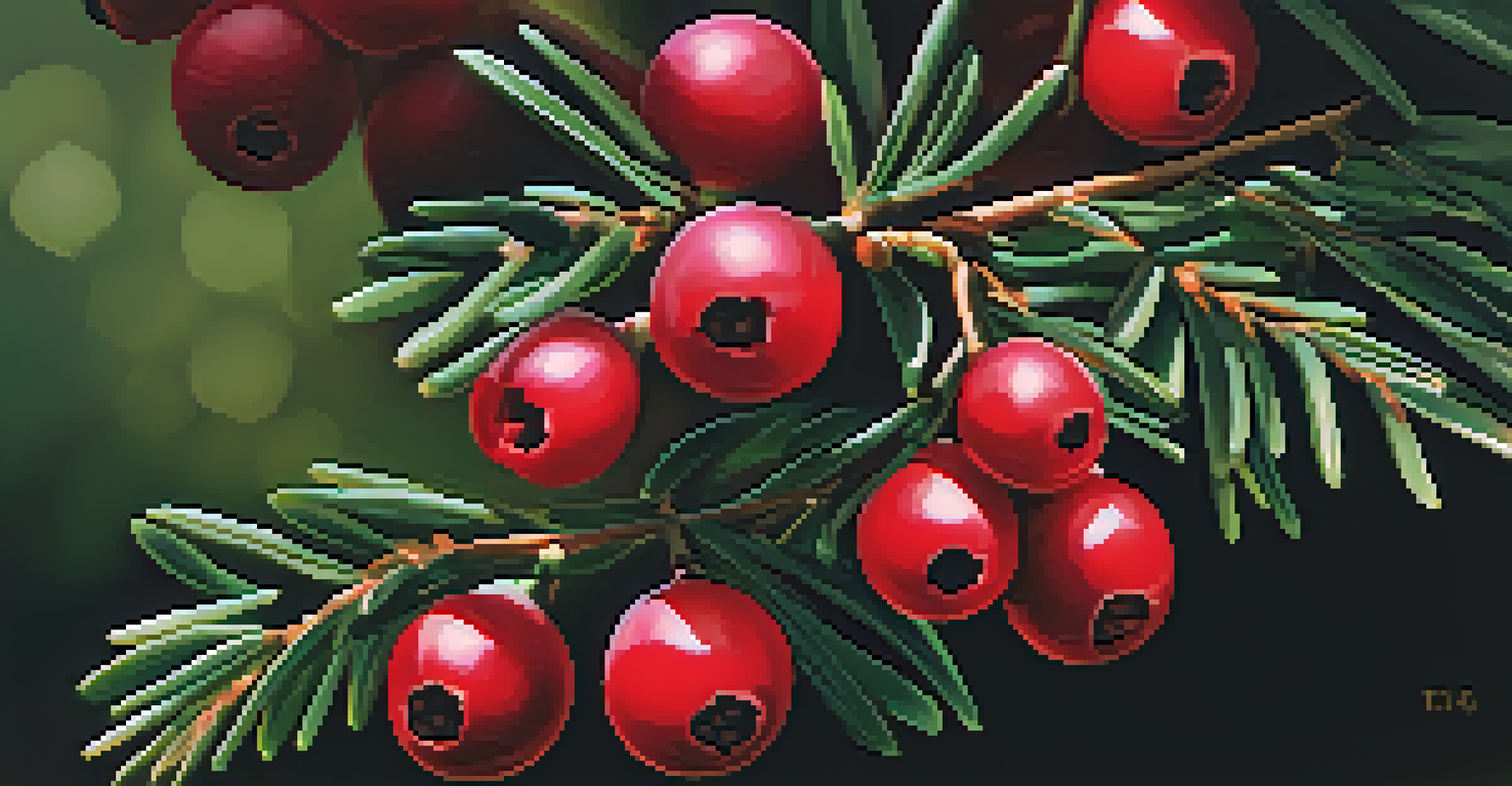The Legend of the Yew Tree: Life, Death, and Rebirth

Introduction to the Yew Tree's Symbolism
The yew tree has long been a symbol of life, death, and rebirth across many cultures. Its evergreen nature signifies endurance, while its association with graveyards links it to mortality. This unique duality makes the yew a powerful emblem in folklore and nature alike.
The yew tree teaches us that beauty is often found in decay and that life is a continuous cycle of endings and beginnings.
Historically, the yew tree has been revered in Celtic traditions, often viewed as a sacred guardian of the afterlife. Its ability to thrive in harsh conditions reflects resilience, suggesting that there is beauty even in decay. This connection to both life and death is what makes the yew tree so compelling.
As we delve deeper into the legend of the yew tree, we’ll uncover the stories and beliefs that have shaped its reverence over centuries. From ancient burial rites to modern interpretations, the yew's narrative is rich and multifaceted.
The Yew Tree in Ancient Mythology
Ancient myths often depict the yew tree as a bridge between worlds—earthly life and the afterlife. In Celtic mythology, it is said that yew trees guard the souls of the departed, providing them a safe passage. Such beliefs underscore the tree's role as a protector and a symbol of continuity.

Additionally, many ancient cultures used yew wood to create bows, linking it to strength and warfare. This practical use added another layer to its mythos, intertwining life, death, and the cyclical nature of existence. The yew tree, thus, embodies both the warrior's spirit and the comfort of the eternal.
Yew Tree: A Symbol of Resilience
The yew tree embodies the duality of life and death, representing endurance and the beauty found in decay.
These ancient stories continue to resonate today, reminding us of the timeless dance between life and death. The yew tree stands as a testament to the belief that every ending is merely a prelude to a new beginning.
The Yew Tree in Folklore and Literature
Folklore surrounding the yew tree is rich with tales of magic and mystery. In many European traditions, yew trees are believed to be enchanted, serving as homes for fairies and spirits. These stories often emphasize the yew’s role as a mystical guardian, evoking curiosity and respect.
In every walk with nature, one receives far more than he seeks.
Literature, too, has embraced the yew tree as a symbol of contemplation and reflection. Poets and authors have often used the yew to represent the themes of mortality and the passage of time. Its presence in literary works helps to convey the complexity of human existence and our relationship with nature.
In this way, the yew tree becomes a powerful metaphor for human emotions—love, loss, and the hope for rebirth. Its deep roots and resilient branches remind us that while we may face endings, new growth is always possible.
The Yew Tree's Role in Modern Culture
Today, the yew tree continues to hold cultural significance in various communities. Its association with death makes it a common sight in churchyards and cemeteries, symbolizing remembrance and reflection. Many people find solace in the presence of these ancient trees during times of mourning.
Moreover, the yew tree has also found its place in modern art and gardening. Artists often depict yews as symbols of endurance and wisdom, while gardeners appreciate their beauty and longevity. This enduring appeal keeps the yew tree a relevant part of contemporary culture.
Cultural Significance of Yew Trees
Throughout history, yew trees have served as symbols in mythology, folklore, and modern culture, emphasizing their role in human emotion and experience.
As we navigate the challenges of modern life, the yew tree serves as a reminder of the cycles inherent in nature. Its ability to thrive through adversity inspires us to embrace our own challenges with resilience and hope.
Ecological Significance of the Yew Tree
Beyond its mythological and symbolic importance, the yew tree plays a crucial role in the ecosystem. It provides habitat and food for various wildlife species, including birds and insects. The yew's berries, while toxic to humans, are a vital food source for birds, illustrating the interconnectedness of life.
Additionally, yew trees contribute to soil health by preventing erosion with their extensive root systems. Their long lifespan—sometimes over a thousand years—makes them a valuable part of the landscape, fostering biodiversity and stability. This ecological role enhances their status as a symbol of endurance and resilience.
Understanding the ecological significance of the yew tree enriches our appreciation of its legacy. It reminds us that every tree, and indeed every life, has a role to play in the larger tapestry of the environment.
Conservation Efforts for the Yew Tree
As we recognize the yew tree's importance, conservation efforts are becoming increasingly vital. Many yew species are threatened by habitat loss and disease, prompting initiatives to protect these ancient trees. Organizations are working to promote awareness and stewardship of yew trees in both urban and rural areas.
In addition to preserving existing trees, propagation programs aim to cultivate new yews for future generations. These efforts not only safeguard the yew's ecological role but also ensure that its rich cultural heritage continues to thrive. Engaging communities in conservation efforts fosters a deeper connection to these magnificent trees.
Conservation of Yew Trees is Crucial
As yew species face threats, conservation efforts are vital to preserve their ecological importance and cultural heritage for future generations.
Ultimately, caring for the yew tree is about preserving a living link to our past while nurturing a sustainable future. Through these collective efforts, we can honor the yew's legacy of life, death, and rebirth.
Conclusion: The Timeless Legacy of the Yew Tree
The legend of the yew tree encapsulates the cycle of life, death, and rebirth in a way that resonates across cultures and time. Its enduring presence in mythology, folklore, and modern life reminds us of our shared human experience. The yew tree stands as a powerful symbol of resilience and continuity.
As we reflect on the stories and significance of the yew tree, we are invited to consider our own connections to nature and the cycles of our lives. Each yew tree is a reminder that endings can lead to new beginnings, echoing the natural rhythms we all experience.

In embracing the legend of the yew tree, we celebrate not just its unique beauty but also the lessons it imparts about existence. Let us continue to honor and protect this remarkable tree, ensuring its legacy of life, death, and rebirth lives on for generations to come.